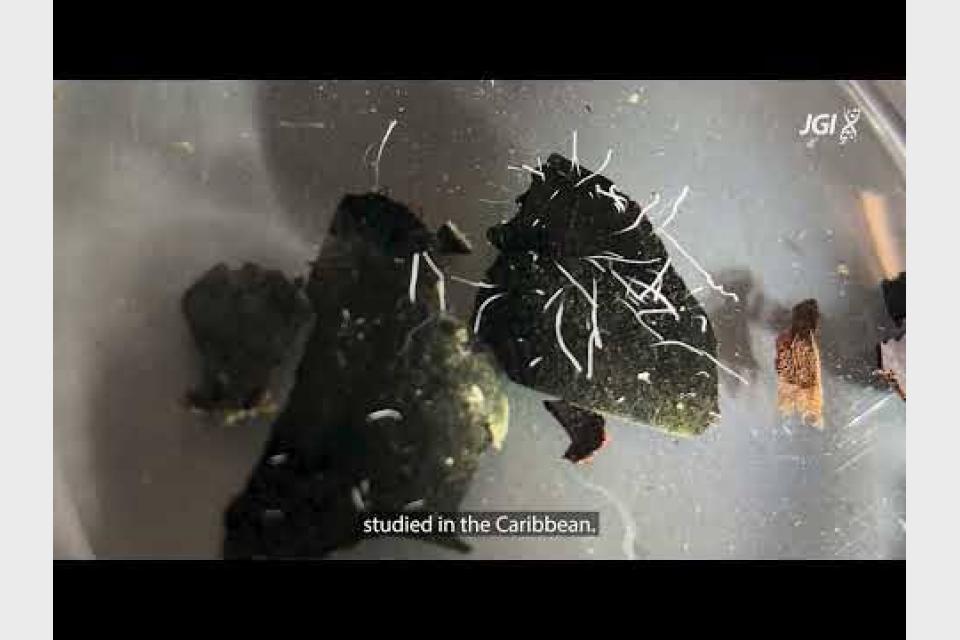Thiomargarita magnifica’s swamp
Olivier Gros, a professor at the University of the French Antilles, has spent two decades digging around for microbes in the shallow waters of the Caribbean mangroves. These swamp-like environments, says Gros in a press conference, “are characterized by low tides and high quantities of organic matter accumulating in or on sediment.”
While the degrading detritus of these mangroves might be inhospitable to humans, it’s a buffet for many microorganisms, which break down the organic muck, producing sulfide, a compound that smells strongly of rotten eggs. It was over a decade ago that, rooting around for samples in the submerged roots of the mangrove trees, Gros came across a thin white filament attached the trees’ sunken leaves.
Gros first thought that the filament belonged to a eukaryote. This was the obvious conclusion – bacteria and eukaryota are two distinct domains of life. While eukaryotes, which sequester their genetic material inside membrane-wrapped nuclei, can grow to massive size (fungi, plants and animals are all eukaryotes), bacteria are, on average, about 2 μm in size – far below the limit that our eye can see.
But peering down his microscope, Gros couldn’t identify any nuclei – the cell’s interior looked much more like that of a bacterium.
Pepins: another aspect of T. magnifica’s weirdness
From this point, T. magnifica became the subject of years of multilevel analysis, which identified that the bacterium’s strangeness did not stop at its size. The cell’s inner space was filled with small organelles that contained DNA and ribosomes – structures that help process DNA. “These compartments represent a new type of bacterial organism that we named pepins, which means in French, the small seeds in fruits. And this is an important observation because until now, the packing of the cell's DNA inside a membrane bound organelle was considered to be strictly limited to the eukaryotic cells,” said Jean-Marie Volland, Gros’s former graduate student and now a scientist at Lawrence Berkeley National Laboratory’s Laboratory for Research in Complex Systems.
Despite having a structure reminiscent of eukaryotes, DNA analysis confirmed that T. magnifica was, without doubt, a bacterium. But even at a genetic level, this unusual microbe has surprises in store. Tanja Woyke, another co-author who works at the Department of Energy’s Joint Genome Institute, explained that while T magnifica’s 12-million base pair genome is very much within the bounds of reason for such bacteria, the number of copies of the bacteria’s genome was on a different magnitude.
This repetition of the genome is known as polyploidy. While humans have two copies of our genetic material in each cell (one from mom and one from dad) and are therefore diploid, it’s not uncommon for other organisms to have more than two sets of genetic material. Some hybrids of wheat are pentaploid, and some strawberries are decaploid. Recently, bacteria with more than ten copies of their genome have been discovered. T magnifica has half a million copies. That works out, says Woyke, at six trillion bases of DNA. “This means that T. magnifica store several orders of magnitude more DNA in itself as compared to human cell,” she adds.
The benefits of being big
T. magnifica’s size and complexity are obvious. But the reasons behind these features remain unclear, the team say. Having sequestered DNA might allow T. magnifica to better control its cellular functions, they suggest. As for why the organism has grown to such a massive size, the researchers can only speculate. One motivation might be survival: “If you grow hundreds or thousands of times bigger than your predator, you cannot be consumed by your predator,” says Volland. Other theories revolve around the bacterium’s unique place at the interface between mangrove sediments, which are devoid of oxygen, and oxygen-rich water. Perhaps, Volland says, growing into a massive filament allows the bacteria to better exploit the chemical gradients present in their environment.
One thing the team is clear on, however, is that T. magnifica’s bacterial genome and eukaryotic size doesn’t make it the missing link between these domains of life. “These bacteria, if anything has evolved, you know, towards maybe higher complexity within their own lineage, but they are not at the origin of complex recorded cells,” Volland says.
Nevertheless, this vast, strange bacterium does raise plenty of questions about our understanding of bacterial complexity, says Volland. “Maybe what it tells us is that we probably are a little bit biased, when we think about bacteria ... Because most of the microbiology research on bacteria has been done on a handful of model systems that have been isolated and are easy to culture in the lab. But there's actually an incredible diversity of bacteria and archaea, and microbes in general, that are much more difficult to find or to study or culture. This tells us that we should probably be looking also outside of the streetlights.”









